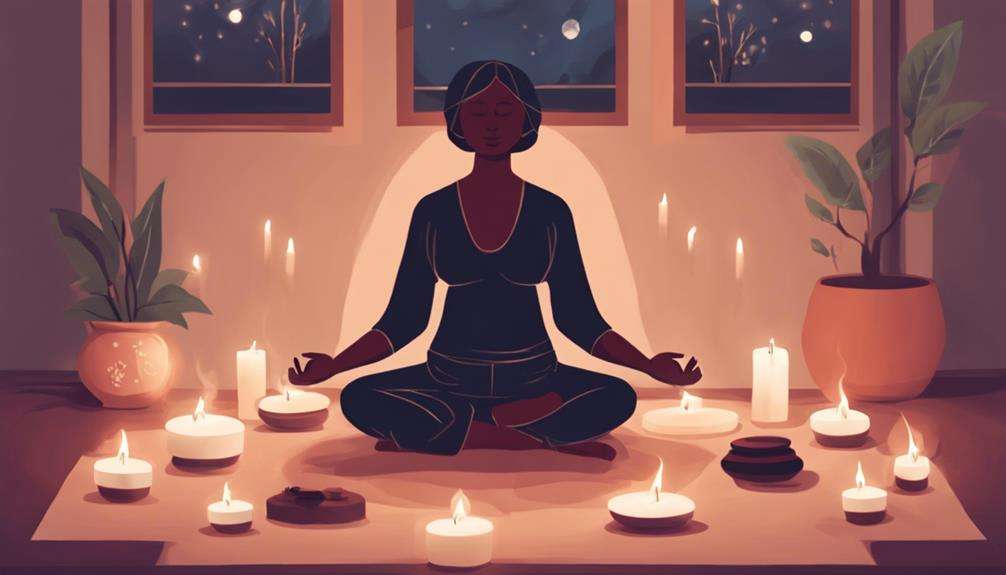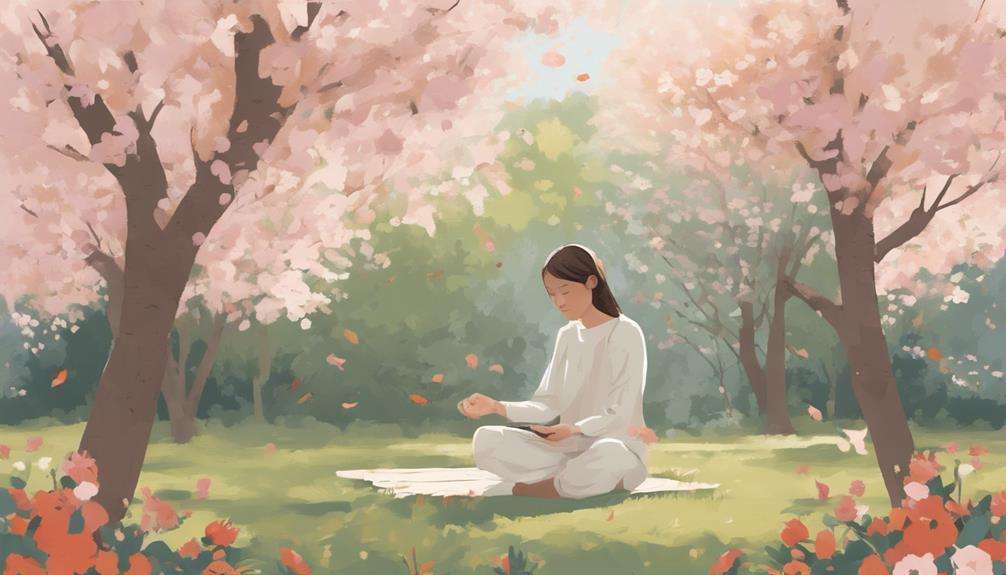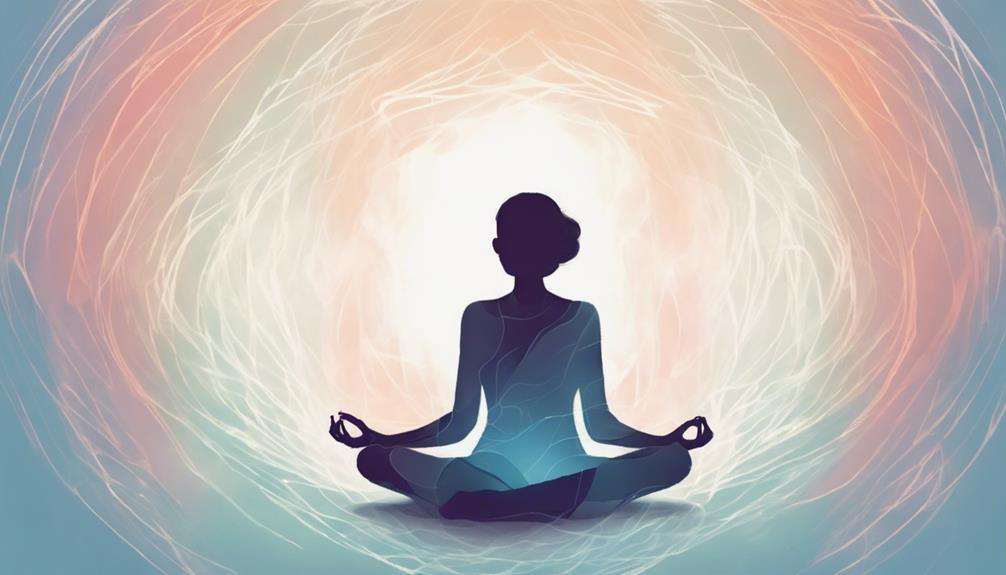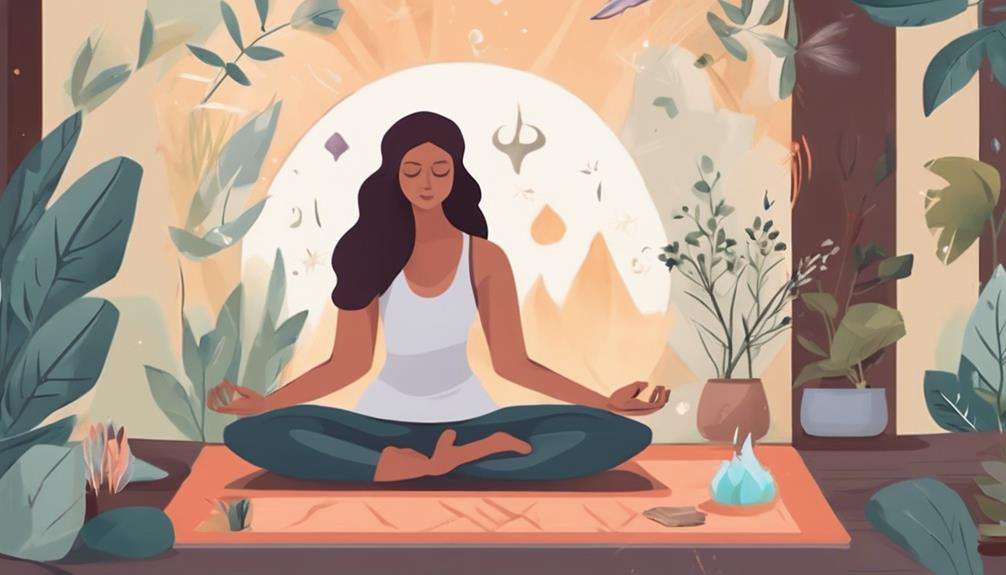If you often find yourself feeling overwhelmed by anxiety, you might question how yoga sequences can truly help ease your mind.
However, by engaging in gentle movements and intentional breath work, you can gradually soothe your nervous system and create a sense of calm within yourself.
Imagine a series of yoga poses designed specifically to quiet the racing thoughts and tension in your body, offering a pathway to tranquility.
Through these purposeful practices, you can begin to unravel the knots of anxiety and discover a newfound sense of peace within.
Key Takeaways
- Gentle yoga poses and breathwork techniques reduce anxiety and promote relaxation.
- Mindful practices like guided meditation aid in stress relief and emotional balance.
- Incorporating restorative yoga and breathwork supports anxiety reduction and mental well-being.
- Regular practice of calming yoga sequences enhances relaxation, focus, and overall stress management.
Gentle Seated Poses
Indulge in the soothing practice of gentle seated poses to ease your mind and find tranquility amidst the chaos of daily life. Yoga offers a powerful tool for combating anxiety by integrating the mind and body. These gentle seated poses are specifically designed to promote relaxation, stress relief, and tension release. By focusing on grounding yourself through these poses, you can experience a profound sense of well-being and mental clarity.
When you engage in gentle seated poses, you allow yourself the opportunity to center your thoughts and emotions. The simplicity of these poses belies their effectiveness in calming the nervous system and quieting the mind. As you breathe deeply and settle into each pose, you create space within yourself for peace to flourish. The beauty of these practices lies in their accessibility; you can practice them anywhere, at any time, to cultivate a sense of inner calm and balance. Embrace the therapeutic benefits of gentle seated poses as you journey towards greater well-being and emotional equilibrium.
Reclined Postures for Relaxation
When it comes to finding relaxation and relief from anxiety, gentle reclined poses can be your go-to. These stretches, combined with soothing breathwork, create a tranquil space for your mind and body.
Embrace the calming nature of reclined postures to unwind and restore balance within yourself.
Gentle Reclined Stretches
Begin your relaxation journey with gentle reclined stretches in yoga to release tension and promote deep relaxation in your body. These poses are especially beneficial for anxiety relief as they offer a soothing way to unwind.
Here are some gentle reclined stretches to help you relax:
- Supine Spinal Twist: Gently twist your spine while lying down, releasing tension and promoting relaxation.
- Constructive Rest Pose: Find comfort in this simple pose that allows for gentle stretches and deep breathing.
- Legs Up the Wall: Elevate your legs against a wall to promote relaxation, improve circulation, and calm your nervous system.
Incorporating these gentle stretches into your yoga practice can create a sense of peace and aid in relieving anxiety symptoms.
Breathwork for Relaxation
To enhance your relaxation experience in yoga, incorporating breathwork techniques in reclined postures can deepen your sense of calm and promote overall well-being. Reclined postures provide deep relaxation by allowing your body to unwind fully, releasing tension and promoting stress reduction.
By incorporating specific breathwork techniques while in these poses, you can enhance the calming effects, further reducing anxiety and promoting relaxation benefits. The combination of reclined postures and focused breathwork not only aids in tension release but also improves sleep quality, leading to better overall well-being.
Regular practice of these techniques can have a significant impact on your mental and physical health, offering a powerful tool for managing stress and promoting deep relaxation.
Soothing Standing Asanas
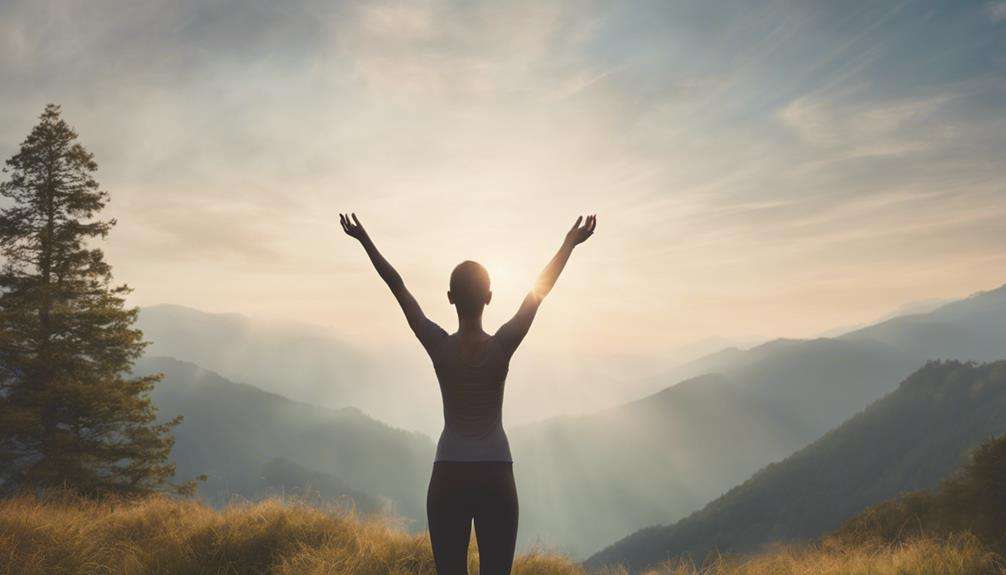
You're ready to explore the soothing world of standing asanas. Poses like Mountain, Tree, and Warrior can offer you stability, balance, and a renewed sense of focus.
Engaging your muscles in these postures not only strengthens your body but also helps ground your energy, promoting a calm and centered state of mind.
Grounding Mountain Pose
Incorporate the Grounding Mountain Pose into your calming yoga routine for a sense of stability and inner peace. Mountain Pose, also known as Tadasana, offers grounding and stability, enhancing posture, balance, and focus.
Here's how to practice it effectively:
- Alignment: Stand tall with feet hip-width apart, grounding through all four corners of your feet.
- Core Engagement: Activate your core muscles by drawing your navel in towards your spine.
- Mindful Breathing: Take deep breaths, feeling the connection between your feet and the earth, fostering a sense of rootedness.
Balancing Tree Pose
Enhance your focus and stability with the Balancing Tree Pose, also known as Vrksasana. This soothing standing asana is a powerful tool for anxiety management, helping you find balance both physically and mentally.
By practicing Tree Pose, you improve concentration, grounding yourself in the present moment. Strengthening your legs and core muscles fosters stability, offering a sense of security. Engaging in this pose encourages mindfulness, calming turbulent thoughts and promoting relaxation.
Through the gentle challenge of maintaining balance, you develop body awareness and proprioception, aiding in anxiety relief. Embrace the tranquility of Tree Pose to center your mind, find your equilibrium, and soothe your spirit.
Energizing Warrior Pose
For a revitalizing boost to your practice and a surge of energy, consider incorporating the invigorating Warrior Pose into your soothing standing asanas routine. Warrior Pose, or Virabhadrasana, promotes strength, focus, and balance through its powerful stance.
Here's why it's beneficial:
- Activates multiple muscle groups, enhancing circulation and energy flow.
- Builds mental resilience and concentration, aiding in anxiety relief and empowerment.
- Releases tension, improves posture, and boosts confidence levels.
Balancing Poses for Stability
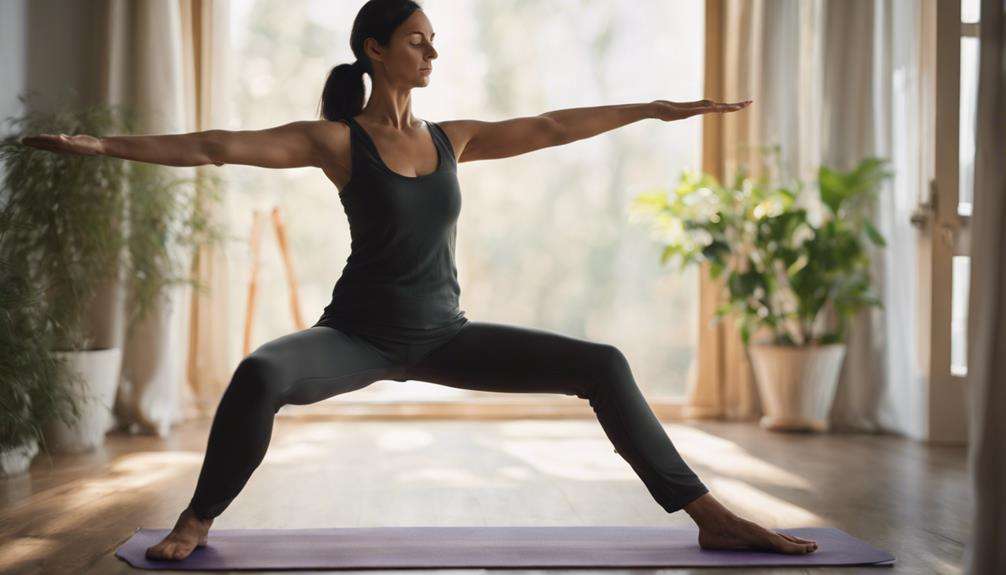
Improve your stability and focus through balancing poses like Tree Pose and Warrior 3 in your yoga practice. These poses work your core muscles and enhance proprioception, helping you find balance both physically and mentally.
Tree Pose, where you stand tall like a tree with one foot rooted to the ground, strengthens your ankle and foot muscles, promoting stability and grounding.
Warrior 3, a pose that requires you to extend one leg back while leaning forward, challenges your balance and concentration.
Heart-Opening Yoga Positions
To cultivate a sense of openness and release tension in your chest and shoulders, exploring heart-opening yoga positions such as Camel Pose and Bridge Pose can be incredibly beneficial. These poses not only help release chest and shoulder tension but also improve posture and breathing by expanding the chest and opening the front body. Through heart-opening yoga poses, you can experience emotional release and vulnerability, which aids in anxiety relief and stress reduction.
Engaging in heart-opening poses promotes self-love and compassion, fostering a deeper connection with yourself. The physical stretching involved in these poses can alleviate the physical symptoms of anxiety, providing relief and relaxation. By practicing heart-opening poses regularly, you can cultivate a sense of openness and mindfulness, allowing you to let go of stress and tension while embracing a state of relaxation and connection.
Embrace these heart-opening yoga positions to nurture your body, mind, and spirit.
Restorative Yoga Sequences
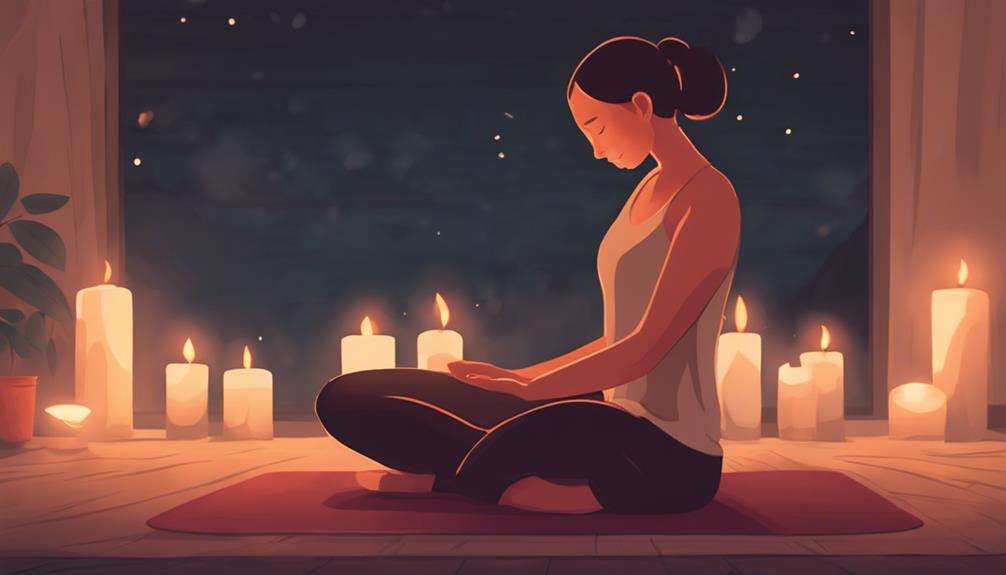
Embrace the gentle and soothing practice of restorative yoga sequences, designed to promote deep relaxation and calmness through passive poses held for extended periods. These gentle poses work to activate the parasympathetic nervous system, helping to calm the body's stress response and induce a state of tranquility. Poses like Supported Child's Pose and Legs-Up-the-Wall are often incorporated into these sequences to release tension and encourage profound relaxation.
Using props such as blankets, bolsters, and blocks, restorative yoga provides support for your body, allowing you to fully relax into each pose without strain. By engaging in restorative yoga regularly, you can reduce anxiety levels, improve the quality of your sleep, and restore balance in both your mind and body.
Mindful Breathing Exercises
Ease into a state of deep relaxation and inner peace with mindful breathing exercises, a powerful practice in yoga that soothes the mind and body. By incorporating these techniques into your yoga routine, you can effectively regulate the sympathetic nervous system, reducing anxiety and stress levels.
Here are three key breathing exercises to help you manage anxiety symptoms and promote overall well-being:
- Alternate Nostril Breathing: This technique involves breathing through one nostril at a time, promoting balance and clarity in the mind.
- Diaphragmatic Breathing: Focus on deep breathing that engages the diaphragm, allowing for increased oxygen flow to the brain and enhancing relaxation.
- Activating the Parasympathetic Nervous System: Through mindful breathing, you can activate the parasympathetic nervous system, inviting a sense of calmness and tranquility into your being. Practice these techniques regularly to reap the benefits of improved mental clarity and emotional balance.
Guided Meditation Practices
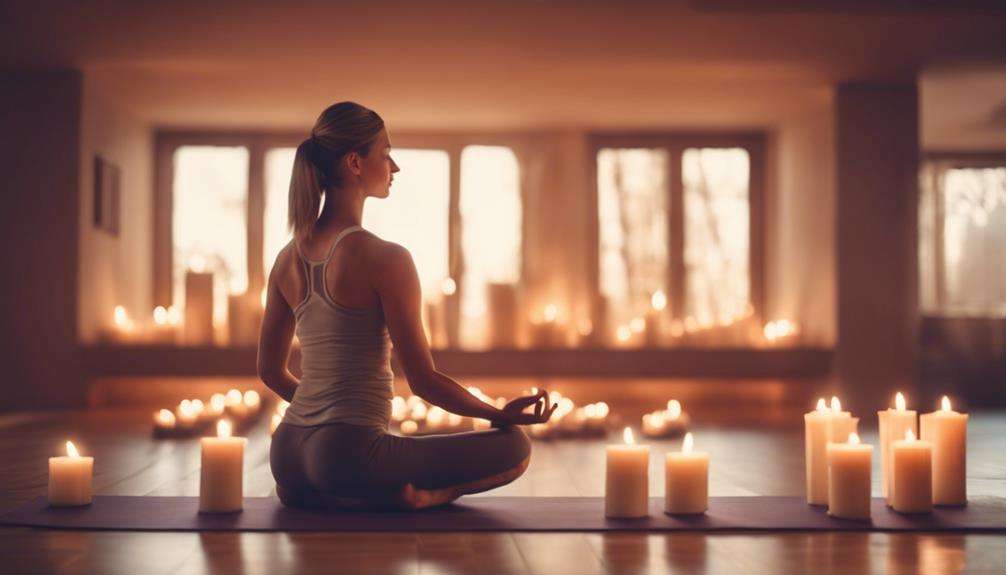
Embark on a journey of inner peace and self-discovery through guided meditation practices led by experienced teachers or through audio recordings. Guided meditations offer a structured approach to meditation, making it easier for beginners to focus, relax, and deepen their practice. During a guided meditation session, the teacher or recording may incorporate various techniques such as breathing exercises, body scans, visualization, and mindfulness. These practices can be customized to target specific needs like anxiety relief, stress reduction, or improving sleep quality.
Research has shown that guided meditation can have significant benefits, including enhanced relaxation, reduced anxiety levels, and overall improvement in well-being. By following the guidance of a skilled teacher or using audio recordings, you can effectively tap into these benefits. Whether you're seeking a moment of calm amidst a hectic day or aiming for long-term stress management, guided meditation can be a valuable tool in your self-care routine. Give yourself the gift of guided meditation and experience the profound effects it can have on your mental and emotional state.
Frequently Asked Questions
Which Yoga Is Best for Remove Anxiety?
To remove anxiety, focus on deep breathing, grounding poses, and gentle stretches in yoga. Cultivate a strong mind-body connection through meditation practice. These relaxation techniques provide stress relief, support self-care, and promote emotional balance for inner peace.
What Is the 3 3 3 Method for Anxiety?
When dealing with anxiety, try the 3 3 3 method. Notice 3 things you see, hear, and move 3 body parts. This grounding technique helps ease stress, promoting mindfulness and relaxation. It's a simple, effective tool for anxiety relief.
Which Yoga Is Best for Panic Attacks?
For panic attacks, focus on deep breathing, grounding poses, and gentle stretches. Calming postures enhance the mind-body connection, promoting stress relief and relaxation. Nourish your nervous system with self-soothing techniques for inner peace.
Which Yoga Is Best for Overthinking?
When overthinking overwhelms, embrace mindful breathing in grounding poses. Relaxation techniques and meditation benefits soothe the mind. Find stress relief through body awareness, fostering mental clarity and emotional balance. Nourish your nervous system with self-care practices.
Conclusion
As you wrap up your calming yoga session for anxiety relief, remember that regular practice can significantly reduce symptoms of anxiety.
In fact, studies have shown that just 15 minutes of mindful yoga a day can decrease stress levels by 27%.
So keep breathing deeply, moving gently, and staying present in the moment to find peace and tranquility within yourself.
You deserve this time for self-care and healing. Keep up the great work!

